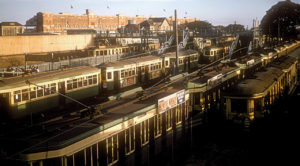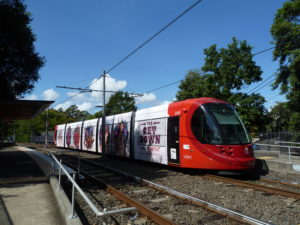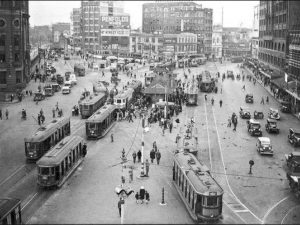
Tramway Facts And Figures
Victor P Taffa
Sydney had the largest Tramway Network outside of London in the British Empire.
Transport Planners and Politicians who do not know or ignore the Past cannot Plan for the Present let alone the Future.
Given what has gone on with closure of Tramways throughout New South Wales it would seem rather mad capped for Light Rail under construction in Sydney not to be compatible with the Dulwich Hill Line and not to connect up with a planned Parramatta Light Rail Line.
Light Rail under no circumstance in Sydney should replace Heavy Rail services. While the St. Kilda Railway Line in Melbourne became a Light Rail Line the distance of the St. Kilda Line from Melbourne CBD compared to Sydney CBD is vastly different.
St. Kilda was already being served by a Tram Route so conversion of the St. Kilda Railway Line that had no prospect of extension was a natural progression to that of a Parramatta-Carlingford Railway corridor route.
Parramatta-North Ryde Light Rail route that serves Macquarie University, Macquarie University Railway Station and Macquarie Shopping Centre, Rosehill Racecourse and Westmead Hospital has a greater chance of success and makes more sense than Parramatta-Carlingford Railway corridor route.
Light Rail should never have replaced Heavy Rail in Newcastle.
Closure of Tramway systems throughout Australia
- Adelaide: November, 1958 (except the Glenelg Line).
- Brisbane: 13 April, 1969
- Hobart: 24 October, 1960
- Perth: 1958
- Sydney: 25 February, 1961 Last Sydney Tram Cars used: R1 2035, 1995, 1961
Dulwich Hill Light Rail Line Commencement Dates
Dulwich Hill Light Rail Line operates on standard gauge track that was originally the Goods Line for Goods Trains from Darling Harbour Yard to the Bankstown Line at Dulwich Hill. The line was built by Dr. John Bradfield who designed and built the Sydney Harbour Bridge and Railways.
- Central-Wentworth Park on 1 September 1997
- Wentworth Park-Lilyfield on 13 August 2000
- Lilyfield-Dulwich Hill on 27 March 2014
What is the difference between Trams and Light Rail?
Main difference is that the workings of a Light Rail vehicle are contained in the roof so that the floor is very close to ground level. Tram cars that operated in Sydney until 1961 had the workings of the vehicle underneath the floor. Thus when boarding a Tram, the passenger had two steps to climb to enter or alight. Nowadays, with disability legislation in place, the old Tram cars would have had to be altered to comply with modern standards.
Sydney Horse, Steam, Cable and Electric Tram Depots:
- Arncliffe
- Baulkham Hills
- Botany
- Bridge Street Yard, now an office block
- Broken Hill
- Dowling Street, Housed 345 tram cars, now a shopping centre
- Enfield at Burwood Road and Tangarra Street, still in existence
- Fort Macquarie, Housed 60 tram cars, now the Sydney Opera House
- Hamilton, Newcastle
- Leichhardt, now a Bus Depot, Bus Museum
- Maitland
- Manly
- Newtown, Housed 93 tram cars, still in existence
- North Mead
- North Sydney, Ridge Street and Military Road Housed 166 tram cars
- Pitt Street, now an office block
- Randwick Workshops, now Randwick TAFE
- Rockdale
- Rozelle, Housed 221 tram cars, still in existence.
- Rushcutters Bay, Housed 64 tram cars, now a Hotel
- Sandringham
- Sans Souci, Richie Street
- Sutherland
- Tempe, Housed 116 tram cars, now a Bus Depot
- Ultimo, Housed 122 tram cars, now the Power House Museum
- Waverley, Housed 217 tram cars, now a Bus Depot
- Wallsend, Newcastle
Sydney Tram Line closures:
- Abbotsford-22 November 1958
- Addison Road-25 May 1957
- Alexandria-2 May 1959
- Ascot Racecourse-April 1949
- Balmain-22 November 1958
- Birchgrove-22 November 1958
- Botany-22 October 1960
- Botany to Yarra Junction-15 March 1935
- Bondi Beach via Bellevue Hill-27 June 1959
- Bronte-27 February 1960
- Coogee Beach-22 October 1960
- Cooks River-28 September 1957
- Cooks River to Dulwich Hill-28 September 1957
- Clovelly-22 June 1957
- Daceyville-22 June 1957
- Darling Street to Canterbury-20 November 1954
- Dulwich Hill-28 September 1957
- Earlwood-28 September 1957
- Enfield-21 August 1948
- Erskineville-6 January 1940
- George Street, City-22 November 1958
- Glebe Point-22 November 1958
- Haberfield-22 November 1958
- Henderson Road-30 July 1933
- Hurlstone Park to Summer Hill-8 July 1933
- King Street, City-1950
- La Parouse-25 February 1961
- Leichhardt-22 November 1958
- Lilyfield-22 November 1958
- Manly-12 October 1939
- Maroubra Beach-25 February 1961
- Millers Point-22 November 1958
- Newcastle System-10 June 1950
- North Bondi-27 February 1960
- North Sydney-28 June, 1958
- Pitt & Castlereagh Streets, City-28 September 1957
- Pyrmont-28 June 1953
- Randwick Racecourse sidings-1 February 1960
- Rosebery-22 June 1957
- Rockdale to Brighton-3 September 1949
- Ryde-18 December 1949
- Ryde to West Ryde Station-11 March 1934
- Showground and Cricket Ground sidings-27 February 1960
- Watsons Bay-9 July 1960
- Waverley-13 November 1954
- West Kensington-11 December 1959
- Woolloomooloo-25 July 1935
What was the ‘tram ferry’?
This was a special punt operating from both sides of The Spit, across Middle Harbour, which carried trams from the isolated Manly system to the North Sydney system. The punt was hauled across by cable and ceased operations in October, 1939.
What was the size of the Sydney Tramway System?
The Sydney Tramway Network had
- Total route distance of 368 km,
- Track distance was 679 km,
- 1,570 tram cars,
- 429 million passengers per year.
What is the current extent of the Melbourne Tramway Network?
As of May 2017, the Melbourne Tramway Network consisted of
- 250 Km of track,
- 493 trams,
- 24 routes,
- 1,763 tram stops
Geographical size and topography are the main reasons why Sydney’s Tramway was much larger than Melbourne’s. This fact alone made destroying Sydney’s Tramway Network a backward move driven by vested interests.
Melbourne’s Tramway Network is the largest operating system in the world at present.
When did the Sydney Tramway System finally close?
On 25 February 1961 the last tram ran from the Hunter Street terminus in Elizabeth Street, Sydney to La Perouse and return to Randwick Workshops.

Randwick Racecourse Tramway Siding that resembled a 6 Platform Railway Station with overhead footbridge moved 90,000 people in 90 minutes after the last race
When did the last tram run in Newcastle?
On 11 June 1950 the last tram ran on the Waratah line.
Did any isolated tram lines exist in Sydney? Yes.
- Rockdale to Brighton-Le-Sands
- Arncliffe to Bexley
- Sutherland to Cronulla
- Ashfield to Mortlake and Cabarita
- Parramatta to Castle Hill
- The Spit (north side) to Manly, Harbord and Narrabeen.
Were any tramways replaced by railways? Yes.
- Sutherland to Cronulla
- Parramatta to Castle Hill and Rogans Hill
Where were the longest tram routes in New South Wales?
- Newcastle to West Wallsend-24.9 km
- Fort Macquarie (now the Opera House) to Ryde-17.3 km
Did any tram line connect to the Railways? Yes.
From Ryde to West Ryde until 11 March 1934 the route left the Ryde Line via sets of points on Blaxland Road at Church Street and traversed Victoria Road along a single track to Ryedale Road where the line connected onto the Northern Railway Line at West Ryde.

 RSS feed
RSS feed 

